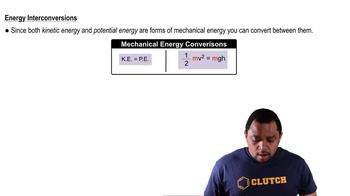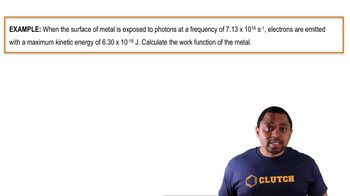Two positively charged particles are first brought close together and then released. Once released, the repulsion between particles causes them to move away from each other. a. This is an example of potential energy being converted into what form of energy?
Ch.1 - Introduction: Matter, Energy, and Measurement
Chapter 1, Problem 32
For each of the following processes, does the potential energy of the object(s) increase or decrease? (b) Water is pumped from ground level to the reservoir of a water tower 30 m above the ground.
 Verified step by step guidance
Verified step by step guidance1
Identify the initial and final positions of the water: initially at ground level and finally at 30 m above ground in the reservoir.
Understand that potential energy is related to the height of an object above a reference point, typically calculated using the formula: $PE = mgh$, where $m$ is mass, $g$ is the acceleration due to gravity, and $h$ is the height above the reference point.
Recognize that as the water is pumped from ground level to a higher elevation, its height $h$ increases.
Since the height $h$ increases, the potential energy of the water also increases according to the formula $PE = mgh$.
Conclude that the potential energy of the water increases as it is pumped to the reservoir 30 m above the ground.

Verified video answer for a similar problem:
This video solution was recommended by our tutors as helpful for the problem above.
Video duration:
1mWas this helpful?
Key Concepts
Here are the essential concepts you must grasp in order to answer the question correctly.
Potential Energy
Potential energy is the energy stored in an object due to its position or configuration. In the context of gravitational potential energy, it is calculated using the formula PE = mgh, where m is mass, g is the acceleration due to gravity, and h is the height above a reference point. As an object is raised to a higher position, its potential energy increases because it has the capacity to do work due to its elevated position.
Recommended video:
Guided course

Kinetic & Potential Energy
Work Done Against Gravity
When an object is moved against the force of gravity, work is done on the object. This work results in an increase in the object's potential energy. In the case of pumping water to a height, energy is expended to lift the water, which translates into an increase in its gravitational potential energy as it is elevated to the reservoir.
Recommended video:
Guided course

Work Function Calculation Example
Conservation of Energy
The principle of conservation of energy states that energy cannot be created or destroyed, only transformed from one form to another. In the scenario of pumping water, the mechanical energy used to pump the water is converted into gravitational potential energy as the water is raised to a higher elevation. This principle helps to understand how energy is transferred and transformed in physical processes.
Recommended video:
Guided course

Law of Conservation of Mass
Related Practice
Textbook Question
Textbook Question
Two positively charged particles are first brought close together and then released. Once released, the repulsion between particles causes them to move away from each other. b. Does the electrostatic potential energy of the two particles increase or decrease as the distance between them is increased?
Textbook Question
Use appropriate metric prefixes to write the following measurements without use of exponents: c. 6.48×10-7 L
Textbook Question
Use appropriate metric prefixes to write the following measurements without use of exponents: d. 1.81×10-2 s
Textbook Question
Use appropriate metric prefixes to write the following measurements without use of exponents: g. 5.1×102 cm
